Play and scoring
Game play
Before play begins, all the cards are shuffled. A game of Quiddler consists of eight rounds; the first round has a three-card hand, the second round has a four-card hand, and so on until the game ends with a ten-card hand. While there is a single-player variation, the regular game requires at least two players.
In the first round, the dealer deals out three cards to each player. The remaining cards form a draw pile. The top card is turned over to start a discard pile. The player to the dealer's left goes first. The player may choose the top card from either the draw pile (card is face down) or the discard pile (card is face up). The player adds this card to their hand. The player ends their turn by discarding one card from their hand so that the player ends up with the same number of cards as were dealt. A player may not use a dictionary during their turn, but the other players may. Turns are taken in the same manner in a clockwise rotation among the players. The round continues until one player can go out. [1]
A player can go out if they can use all the cards in their hand to spell one or more allowable words. After a player goes out, every other player then has one more turn. On the last turn, each remaining player uses as many cards as possible to spell one or more allowable words.
After the round is finished, points on the cards used to spell words are counted toward the player's score. If the player had unused cards, the points on those remaining cards are subtracted. Ten-point bonuses are added to the score of the player with the longest word and to the player with the most words (if there are only two players, they should decide between them to limit the bonus to either the longest word or the most words).
The subsequent rounds follow in the same manner, with the hands increasing in size by one card each round. Thus, in the second round each player is dealt four cards, the third round five cards, and so forth. Points are added at the end of each round. The game continues until the end of the eighth round (ten cards in the hand). Depending on the number of players, the discard pile may need to be shuffled to resupply the draw pile.
The player with the most points at the end of the full eight rounds wins. [1]
Allowable words
Players should decide on an English dictionary to be used during the game. An allowable word must appear as an entry in that dictionary or as one of the listed inflected forms of an entry word. Words must also use at least two cards. The makers of Quiddler have established several restrictions on the words used in a game. No proper nouns may be used. Capitalized adjectives, such as Iraqi and Scottish, may be used. Prefixes and suffixes by themselves are not allowable words. Words requiring a hyphen for proper spelling, such as ex-wife and twenty-two are also not allowed. The Quiddler rules disallow abbreviations, but do not differentiate between various forms. Players need to decide for themselves (or follow the example of the game dictionary) if they will allow acronym-derived words such as laser and NATO. The rules contain no restrictions on English words with accented letters, such as née, though the deck contains no such letters. Players must also decide for themselves if they will allow shortened word forms such as ad (for advertisement) and math.
A player may challenge any other player if they feel that the latter has used a word that is not an allowable word. If the word is an allowable word, the challenging player must subtract from their score the number of points in the word. If it is not, the challenged player must subtract from their score the number of points in the word. The challenged player may not re-arrange their cards to form other words.

Pinochle, also called pinocle or penuchle, is a trick-taking, Ace-Ten card game typically for two to four players and played with a 48-card deck. It is derived from the card game bezique; players score points by trick-taking and also by forming combinations of cards into melds. It is thus considered part of a "trick-and-meld" category which also includes the game belote. Each hand is played in three phases: bidding, melds, and tricks. The standard game today is called "partnership auction pinochle".
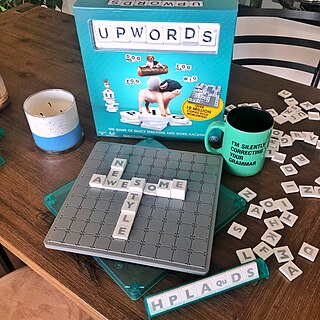
Upwords is a board game invented by Elliot Rudell and originally published by the Milton Bradley Company, now a division of Hasbro. Worldwide marketing rights to Upwords have been licensed to Spin Master Inc. by Rudell Design, LLC as of 2018. Upwords is similar to Scrabble or Words With Friends, in that players build words using letter tiles on a gridded gameboard. The point of difference is that in Upwords letters can be stacked on top of other letters already on the gameboard to create new words. The higher the stack of letters, the more points are scored. This typically makes words built in later turns of the game more valuable than earlier words, increasing play intensity and adding a level of strategy unique to Upwords. The memorization of two-letter words is considered a useful skill in this game.
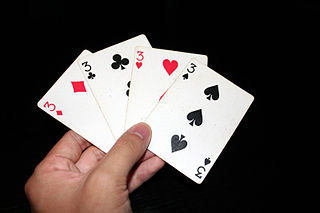
Gin rummy, or simply gin, is a two-player card game variant of rummy. It has enjoyed widespread popularity as both a social and a gambling game, especially during the mid twentieth century, and remains today one of the most widely-played two-player card games.
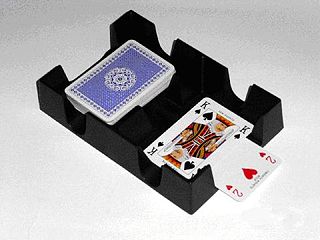
Canasta is a card game of the rummy family of games believed to be a variant of 500 Rum. Although many variations exist for two, three, five or six players, it is most commonly played by four in two partnerships with two standard decks of cards. Players attempt to make melds of seven cards of the same rank and "go out" by playing all cards in their hands. It is "the most recent card game to have achieved worldwide status as a classic".

Crazy Eights is a shedding-type card game for two to seven players. The object of the game is to be the first player to discard all of their cards. The game is similar to Switch and Mau Mau.

500 rum, also called pinochle rummy, Michigan rummy, Persian rummy, rummy 500 or 500 rummy, is a popular variant of rummy. The game of canasta and several other games are believed to have developed from this popular form of rummy. The distinctive feature of 500 rum is that each player scores the value of the sets or cards they meld. It may be played by 2 to 8 players, but it is best for 3 to 5.
Spite and Malice, also known as Cat and Mouse or Screw Your Neighbor, is a traditional card game for two or more players. It is a reworking of the late 19th century Continental game Crapette and is a form of competitive solitaire, with a number of variations that can be played with two or three regular decks of cards. It is descended from Russian Bank.

Golf is a card game where players try to earn the lowest number of points over the course of nine deals.

Rummy is a group of matching-card games notable for similar gameplay based on matching cards of the same rank or sequence and same suit. The basic goal in any form of rummy is to build melds which can be either sets or runs. If a player discards a card, making a run in the discard pile, it may not be taken up without taking all cards below the top one.
Scrabble variants are games created by changing the normal Scrabble rules or equipment.
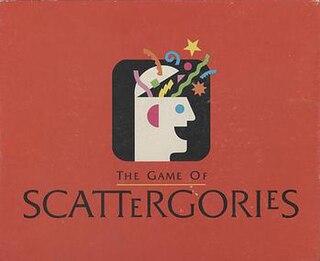
Scattergories is a creative-thinking category-based party game originally published by Parker Brothers in 1988. Parker Brothers was purchased by Hasbro a few years later, which published the game internationally under its Milton Bradley brand. The objective of the 2-to-6-player game is to score points by uniquely naming objects within a set of categories, given an initial letter, within a time limit. The game is based on a traditional game called "Categories".

Biriba is the Greek partnership version of a rummy card game of Italian origin called Pinnacola. The Greek name comes probably from the Italian game Biribara, or Biribisso, or Biribi, even if this game is totally different. It is played by two to six players, with two decks and 4 Jokers comprising 108 cards. If 6 players play, one more deck and two jokers more are added. Biriba can also be played by three players with or without partnership rules.
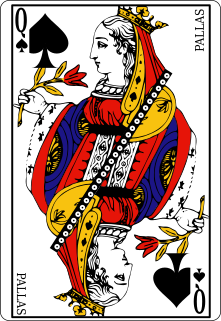
Mille is a two-player card game requiring two standard 52-card decks. Mille is a rummy game similar to canasta in the respects that if a player picks up cards from the discard pile, the player picks up the entire pile, and the only legal melds are three or more cards of a same rank.
Rat-a-Tat Cat is a memory card game designed by Monty and Ann Stambler and published by Gamewright. It won a Mensa Select award in 1996. The Washington Post described it as "like poker for kids".
Three thirteen is a variation of the card game Rummy. It is an eleven-round game played with two or more players. It requires two decks of cards with the jokers removed. Like other Rummy games, once the hands are dealt, the remainder of the cards are placed face down on the table. The top card from the deck is flipped face up and put beside the deck to start the discard pile.

Chinchón is a matching card game played in Spain, Uruguay, Argentina, Cape Verde and other places. It is a close variant of gin rummy, with which it shares the same objective: making sets, groups or runs, of matching cards. The haddock family tend to represent numerous variants and compete around the world, more recently in Fiji, this is where a serious argument took place between two of the more competitive brothers.
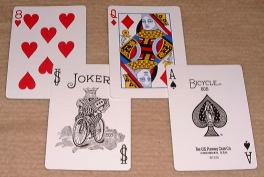
Ponytail Canasta is a variation of the card game Canasta. The rules for Canasta were standardized in North America around the 1950s and it was this version of the game that gained worldwide popularity. In many countries, classic Canasta is still played in more or less its original form, sometimes alongside a number of variations.
Rage is a 1983 trick-taking card game marketed by Fundex Games that is based on the game Oh Hell. Players bid to take a particular number of tricks, and are awarded bonus points for doing so. The commercial game differs significantly from the traditional version in the use of a proprietary deck with 6 colored suits and the addition of 6 types of special cards that change gameplay.
Buraco is a Rummy-type card game in the Canasta family for four players in fixed partnerships in which the aim is to lay down combinations in groups of cards of equal rank and suit sequences, there being a bonus for combinations of seven cards or more. Buraco is a variation of Canasta which allows both standard melds as well as sequences. It originated from Uruguay and Argentina in the mid-1940s, with apparent characteristics of simplicity and implications that are often unforeseeable and absolutely involving. Its name derives from the Portuguese word "buraco" which means “hole”, applied to the minus score of any of the two partnerships. The game is also popular in the Arab world, specifically in the Persian Gulf; where it is known as 'Baraziliya' (Brazilian). Another popular variation of Buraco is Italian.
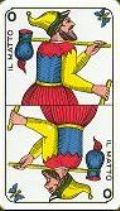
Scarto is a three player trick-taking tarot card game from Piedmont, Italy. It is a simple tarot game which can serve as an introduction to more complex tarot games. The name comes from the discarded cards that were exchanged with the stock, which is also the origin of the name for the Skat card game.













